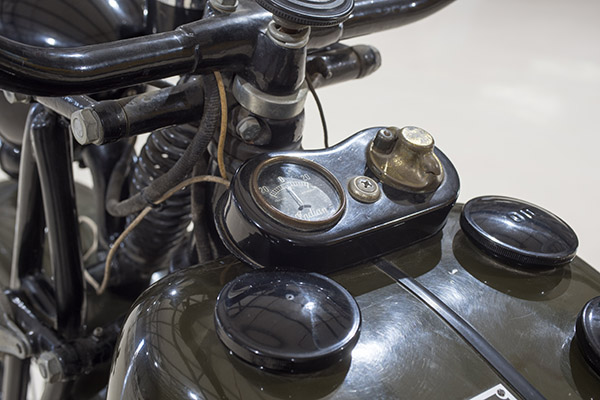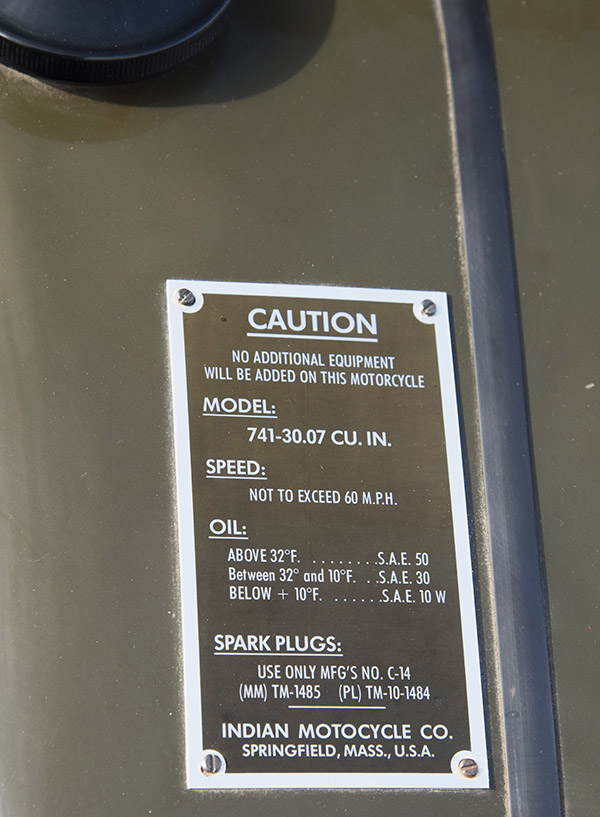By Joe Berk
We were visiting the Planes of Fame last month when I spotted the US Army World War II motorcycle you see below…

At first, I thought it was a Harley WLA 45, but nope, a nice young fellow named Paul was working on the motorcycle and he told me it was an Indian. Wow, you don’t see too many WWII US Army Indians. I was a bit embarrassed (after all, I wrote a book about police and military motorcycles), but the beauty of this motorcycle soon made me forget that. Check out these photos, folks…







When I returned home, I had to look up what I had written two decades ago about the Indian 741 in The Complete Book of Police and Military Motorcycles…
INDIAN WORLD WAR II MOTORCYCLES
During the war, Indian produced about 40,000 motorcycles and essentially devoted its entire operation to military production. It produced few civilian motorcycles (the company did not even bother to print a catalog in 1942), although it maintained a small amount of its production capacity for police motorcycles. It sold its military motorcycles to the U.S. Army and to several other Allied nations, most notably England. Indian offered several models during World War II. These included the Model 741, the Chief, the Model 640B, the M1, and the Model 841.
The Model 741
The Model 741 was Indian’s main military motorcycle. It was the machine Indian had developed in response to the U.S. Army’s ill-advised initial requirement for a 500-cc military motorcycle. The Model 741’s engine actually displaced 30.5 cubic inches (or 500 cc), and for this reason it became known as the “30-50.”
The Model 741 was based on Indian’s Junior Scout. Its 500-cc, V-twin engine was the Junior Scout engine detuned for increased durability. It only produced about 15 horsepower. The Model 741 had a hand shift and a foot clutch like the Harley-Davidson WLA, but the Indian motorcycle put the shifter on the right side of the gas tank instead of on the left side as Harley-Davidson had done. The motorcycle’s throttle was in the left handgrip, in accordance with the army’s initial specification. As Harley-Davidson had done, Indian extended the front forks to give greater ground clearance. Indian also extended the rear frame for the same purpose. The Model 741 also used the much larger Indian Chief’s transmission for increased reliability. The Model 741 had a rifle scabbard on the right front fender and an ammunition container on the left front fender.
The Indian Model 741, like the Harley- Davidson WLA, was not a high-performance motorcycle. Both machines weighed over 500 pounds. Both machines had top speeds of approximately 65 mph. The army was more interested in durability than in top speed.
The U.S. Army used the Indian Model 741 during World War II, as did the armies of Great Britain, Canada, Poland, Australia, and Russia. Indian also sold Model 741s to the British Royal Air Force.
Here’s the best part of this story…The Complete Book of Police and Military Motorcycles is still in print, it’s just $12.95, and all you need to do to order it is click on the link you see here.
Oh, and one more thing. If you live for the sound of exotic ExhaustNotes, I saved the best for last…
Join our Facebook ExNotes page!
Never miss an ExNotes blog:



Left-hand throttle, right-foot shift, fiddle and click, fiddle and click, then “fire in the hole”! The gas tank needed a special double-domed relief for the coconut balls sported by the guys who rode those things in wartime…
I always thought that harley won the government bid and all ww2 military bikes where harleys. Thank you for the article . I learned a lesson today .
They had Indians and Harleys, and there was quite a story between the War Department and Harley and Indian. The War Department said they wanted a 500; both Indian and Harley had 750s. Indian designed a new bike (the 500 in these pictures); Harley told the Army, look, we have a 750, take it or leave it. The Army took it.
Hey Joe,
Beautiful bike. A true motorcycle. Hard to believe the tolerances were so large that the engine needed 50w oil above 32 deg. So, did Paul move the shifter and throttle. I noticed that his bike has the throttle on the right and I believe the shifter on the left.
Baja John
The shifter is on the left and it is a hand shifter. The bike has a foot operated clutch.
Great story. I look forward to seeing it in person.